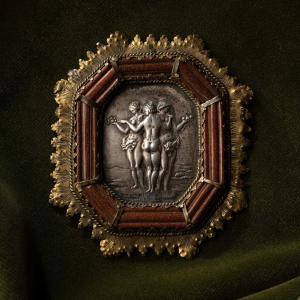Silver, brass, aventurine.
Venice.
Late 17th century.
h. 3.94 in. ; w. 3.54 in. This repoussé silver plaque is a rare, possibly unique adaptation of the famous Three Graces motif, one of the most recognizable themes in Renaissance art since the late 15th-century discovery of an imperial-era marble group preserved in the Piccolomini Library in Siena, translated into painting by Raphael and into engraving by Marcantonio Raimondi. The first imitation of the Piccolomini Three Graces is likely due to Niccolò Fiorentino, whose medals were struck before 1495. A later medal, commissioned in 1549 by Charles V in memory of his late wife Isabella of Portugal, clearly reflects the influence of Raphael’s Three Graces, dated around 1503–1505, likely through their dissemination via Marcantonio Raimondi’s engravings. Charles V’s medal, struck in gold and silver, was commissioned from Leone Leoni, a sculptor and medalist trained in Venice. On the reverse of this medal, which features a portrait of Isabella of Portugal, the Three Graces appear, unmistakably inspired by Raimondi’s engravings. Leoni, however, adds two putti playing around the Graces, their gender—but not their backsides—veiled by the movement of a drapery. This motif, similar to the present silver relief, makes the latter particularly unusual and rare: while “modesty overpainting” emerged under Paul IV, after he tasked Daniele da Volterra in the early 1560s with “reclothing” certain figures painted by Michelangelo in the Sistine Chapel, and while 1563 is often considered a turning point, when the twenty-fifth session of the Council of Trent adopted decrees prohibiting certain depictions of human figures and actions in painting and sculpture, it is less expected to see such modesty applied to a subject so inherently erotic. The relief is mounted on a frame of brass and aventurine—a glass paste mixed with copper crystals, a technique first documented in the inventory of a Murano jeweler in 1626, then in 1663 in the notebook of Venetian glassmaker Giovanni Darduin. This technique, never disclosed by Venetian artisans before the mid-19th century, fell partially into obscurity during the 18th century before being revived and widely disseminated in the 1830s by Murano manufactories. The dual connection of this relief to Venice—through the precedent of Leone Leoni’s silver medals, as he was trained in Venice, and especially through its aventurine frame—suggests its attribution to a Venetian workshop of the late 17th century, based on its iconography. Sources Jean-Claude Boulogne, Histoire de la pudeur, Paris, 1986 ; Cristina Tonin, ‘Stefano Miotti and the Use of Aventurine from the Late 1700s to the Early 1800s’, in Journal of Glass Studies, vol. 50, 2008.






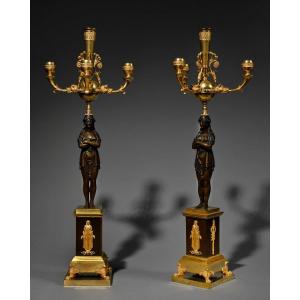



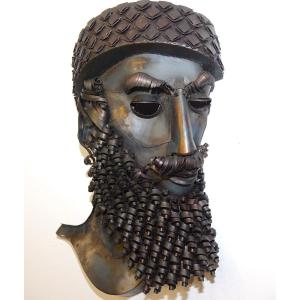
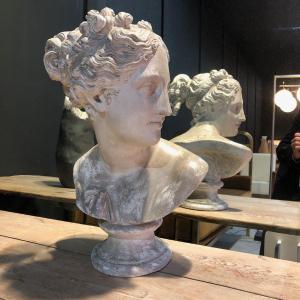
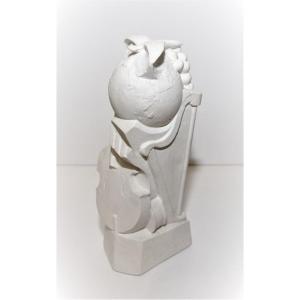






 Le Magazine de PROANTIC
Le Magazine de PROANTIC TRÉSORS Magazine
TRÉSORS Magazine Rivista Artiquariato
Rivista Artiquariato
